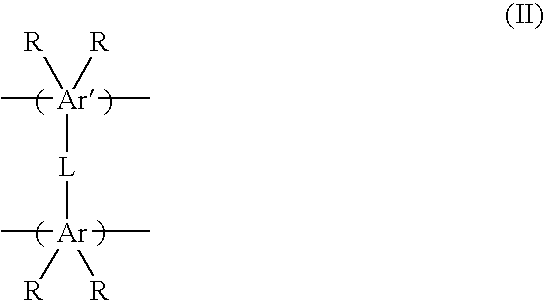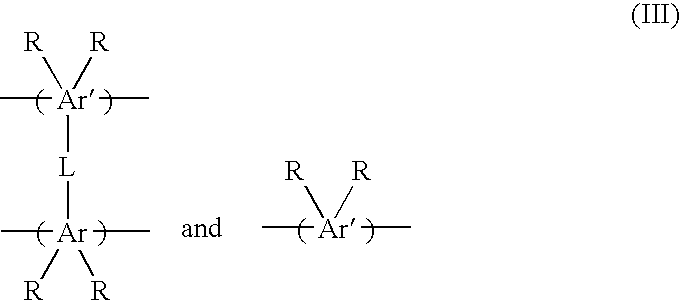Porous materials
a technology of porous materials and blocks, applied in the direction of resistive material coating, liquid/solution decomposition chemical coating, superimposed coating process, etc., can solve the problems of block copolymer approach providing only a limited reduction of the dielectric constant of the matrix material, and the methodology is unsuitable for such electronic devices and integrated circuits, and achieves the effect of increasing the size and non-uniformity of pores
- Summary
- Abstract
- Description
- Claims
- Application Information
AI Technical Summary
Benefits of technology
Problems solved by technology
Method used
Image
Examples
example 1
[0091]A vinylanisole containing cross-linked porogen was prepared by polymerizing the monomers vinylanisole / styrene / trimethylolpropane triacrylate in a weight ratio of 45 / 45 / 10.
[0092]Approximately 2 mL of a 35 wt % solids solution of a commercially available B-staged benzocyclobutene (“BCB”) in mesitylene and 2 mL of a 15 wt % solids solution of the porogen in mesitylene were combined in a 20 mL vial and mixed thoroughly. The resultant pale yellow transparent solution contained 70% BCB and 30% porogen with a total solids content of 25%. 2 mL of the solution was disposed by a pipette onto a stationary 4 inch (ca. 10 cm) wafer on a spin coater. The wafer was then spun at 2500 rpm for 30 seconds and the wafer was removed and the film visually examined. The BCB / porogen film was clear and free of visible defects, striations or haze. The wafer was then heated to 150° C. on a brass hot plate for 1 minute to remove excess solvent. The film was then again visually examined and was clear and ...
example 2
[0093]The following porogen samples were prepared by polymerizing the monomers in the amounts reported in Table 1.
[0094]
TABLE 1PorogenSampleMonomer AMonomer BCross-linker CA / B / CA STY NVP TMPTA 45 / 45 / 10BNVP—TMPTA90 / 10CSTYNVPTMPTA80 / 10 / 10DSTYVASTMPTA45 / 45 / 10ESTYNVPIMTMPTA45 / 45 / 10FSTY4FSTYTMPTA80 / 10 / 10GSTYVASTMPTA80 / 10 / 10
example 3
[0095]The compatibility of a number of porogen samples from Example 2 in B-staged polyarylene ether dielectric materials in cyclohexanone was determined. The B-staged polyarylene ether material was either VELOX A poly(arylene ether) (“Polyarylene ether A”) or VELOX N poly(arylene ether) (“Polyarylene ether N”), both available from Air Products / Shumacher. Both commercially available B-staged materials had a molecular weight of approximately 50,000. Compatibility determinations were performed by visually inspecting a film of the B-staged polyarylene ether dielectric material and porogen that was spun cast on a silicon wafer at 1000 rpm. The porogen was loaded into the B-staged polyarylene dielectric material at ca. 50% by weight with a total solids content of ca. 20%. The film thicknesses were from 0.9 to 2 μm. All visual inspections were by naked-eye under daylight. Film compatibility of the porogen in the polyarylene ether dielectric material was determined after removal of the solv...
PUM
| Property | Measurement | Unit |
|---|---|---|
| mean particle size | aaaaa | aaaaa |
| pore sizes | aaaaa | aaaaa |
| sizes | aaaaa | aaaaa |
Abstract
Description
Claims
Application Information
 Login to View More
Login to View More - R&D
- Intellectual Property
- Life Sciences
- Materials
- Tech Scout
- Unparalleled Data Quality
- Higher Quality Content
- 60% Fewer Hallucinations
Browse by: Latest US Patents, China's latest patents, Technical Efficacy Thesaurus, Application Domain, Technology Topic, Popular Technical Reports.
© 2025 PatSnap. All rights reserved.Legal|Privacy policy|Modern Slavery Act Transparency Statement|Sitemap|About US| Contact US: help@patsnap.com



